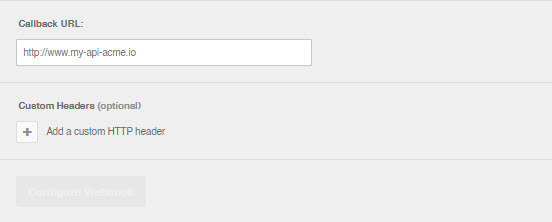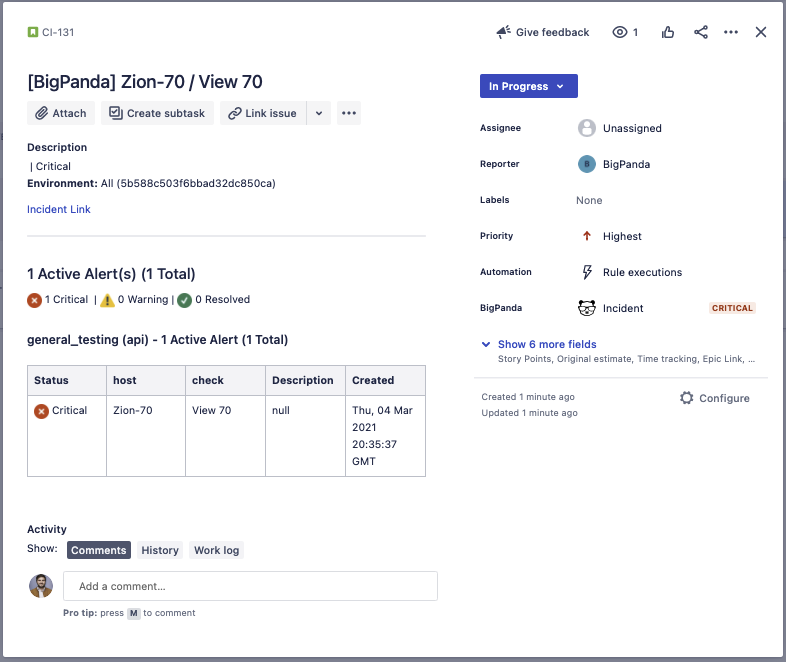Jira Issues - Cloud
Automatically create Jira issues from incidents in BigPanda.
| Supported Versions | Type | Authentication Type |
|---|---|---|
| Jira Cloud | Connect App | API Key and Bearer Token |
The BigPanda for Jira integration allows you to automatically create actionable Jira Issues based on high-level correlated BigPanda incidents. Jira issues are synchronized with the corresponding BigPanda alerts allowing you to continue working in Jira while benefiting from BigPanda’s tools. The integration allows you to configure parameters in Jira for the customization of each project instance.
When a BigPanda incident is shared through the Jira integration, a corresponding issue is created in Jira with details of the correlated alerts and links to the BigPanda incident. Changes occurring to the BigPanda Incident will update the corresponding Jira issue. Additionally, if changes occur to the Jira issue, then it updates the corresponding BigPanda.
Compatible Versions
The Plugin is not compatible with JIRA Service Manager.
Next-Gen projects require that all fields that are mapped within the BigPanda Jira app (Priority, Status, etc.) need to also be included in the Create Issue screen for each Issue Type.
Key Features
- Bidirectional Logic: Configurable settings that allow resolve events for BigPanda incidents to automatically resolve a Jira issue. In addition, you can enable that incidents reopened in BigPanda can reopen a Jira issue.
- Priority synchronization: Priority levels set for BigPanda incidents can automatically set the priority levels of corresponding Jira Issues.
- Direct link to BigPanda incident: Links directly from the Jira issue to the BigPanda incident allowing you to view the incident details, the incident preview page, and the incident timeline. You can also view the alerts and changes occurring in the BigPanda console.
- Field Mapping: Align certain BigPanda alert tags to the fields used by your project's issue type, whether required or optional.
- Multi-integration: Allows you to set up an integration for each of your Jira projects.
Jira Sync and AutoShare
The JIRA integration follows standard AutoShare rules for outbound shares.
The bi-directional sync is time based, and is in addition to the outbound sharing updates. Changes in either BigPanda or Jira are synchronized within the other platform. By default, information is updated every 15 seconds reducing latency synchronization to less than 5 minutes. As a result, you are provided with an up-to-date view of incidents at real-time.
See Manage AutoShare for more information.
Install the Integration
Create an App Key
Create an app key in BigPanda.
Integration specific
You'll need a separate app key for each integrated system.

App Key Configuration in BigPanda
Create a BigPanda API Key
- Generate an API Key
- Note the API Key for use later in the setup
Configure the Integration Webhook
- Set the value of the
x-bp-api-keyheader below to the API Key you created in the previous step - Click Configure Webhook

Webhook Builder
Install the BigPanda App in Jira
Install the BigPanda Jira Application from the Atlassian Marketplace
- In Jira navigate to Settings > Find new apps
- Search for BigPanda
- Click the BigPanda application
- Click the yellow Get app button
- Click Get it now to install the BigPanda Jira application
The install may take some time. Wait to move to the next step until the installation is complete.
Connect Jira to BigPanda
-
In Jira from the top bar navigate to Apps > BigPanda
-
Fill in the Access Token and API Key fields:
- Access Token:
<Your Org Bearer Token> - API Key: API Key Created Earlier
- Access Token:
-
Click Save
Basic Configuration of the Jira Integration
-
From the BigPanda app configuration select Projects
-
Click Add Project to connect a Jira Project to this integration. The Project Configuration form should appear.
-
Fill in the App Key field:
- App Key:
<Your App Key>
- App Key:
-
Select the Jira Project you wish to connect to this integration
-
Select the Jira Issue Type you wish to use for issues created by this BigPanda integration
-
Configure the Bi-Directional Logic
- Auto Resolve BigPanda Incident: Toggle on if resolving a Jira Issue should also resolve the connected incident in BigPanda
- Auto Resolve Jira Issues: Toggle on if resolving a BigPanda incident should also resolve the connected Jira Issue
- Auto Re-Open Jira Issues: BigPanda incidents will automatically reopen if alerts are triggered within a short window. Toggle on if the connected Jira Issue should reopen. Toggle off for the reopened BigPanda incident to create a new Jira Issue.
- Re-Open Window (min): If Auto Re-Open is toggled on select the time frame that a closed alert should reopen the Jira Issue.
-
Configure the Status Mapping behavior, defining which Jira issue status to use for creation and update events.
-
Configure the Priority Mapping behavior, selecting the default Jira issue priority as well as what Jira issue priority to use for each BigPanda priority
-
Click Save to save your changes
After saving, any BigPanda incidents that are shared to this integration will create corresponding issues in Jira.
Jira Create Issue Fields
All fields that are mapped within the BigPanda Jira app (
Priority,Status, etc.) need to also be included in the Create Issue screen for each Issue Type.
Advanced Configuration and Customization
The fields on the configuration page can be updated and customized to reflect your unique needs.
Jira Field Customization
In Field Mapping, you can define the BigPanda Incident Tags that will map to different required or optional fields for a specific Project/Issue Type. In addition to the field name, you will need to define the data type that each field has in JIRA: (Boolean, Integer, String, Array of Strings, or Array of Integers).
In Issue Summary, you can define a description template for a Jira issue. By default, BigPanda provides the following template:
h2. {{priority}} | {{status}}
*Environment:* {{env_name}} {{env_id}}
[Incident Link|{{incident_link}}]
----
h2. {{active_alert_count}} Active Alert(s) ({{alert_count}} Total)
(x) {{critical_count}} Critical | (!) {{warning_count}} Warning | (/) {{ok_count}} Resolved
{{alerts_table}}
However, you can customize the way the BigPanda incident information is presented in the Jira issue by using the Jira Markup Syntax For more information, see the Jira documentation.
Jira Create Issue Fields
All fields that are mapped within the BigPanda Jira app (
Priority,Status, etc.) need to also be included in the Create Issue screen for each Issue Type.
The below parameterized fields available for customization are:
| Jira Description Field | Description |
|---|---|
{{priority}} | Priority tag from BigPanda |
{{status}} | The incidents |
{{start_time}} | Time of when the incident started in BigPanda |
{{incident_link}} | Link that points back to the incident in BigPanda |
{{env_name}} | The name of the environment from BigPanda See Environments |
{{env_id}} | The id of the environment |
{{alert_count}} | Total number of alerts in the incident in BigPanda |
{{active_alert_count}} | Number of alerts either in a critical or warning state in the incident in BigPanda |
{{critical_count}} | Number of critical alerts in the BigPanda incident |
{{warning_count}} | Number of warning alerts in the BigPanda incident |
{{ok_count}} | Number of resolved alerts in the BigPanda incident |
{{acknowledged_count}} | Number of acknowledged alerts in the BigPanda incident |
{{unknown_count}} | Number of unknown alerts in the BigPanda incident |
{{alerts_table}} | The list of alerts from the BigPanda Incident |
View the Jira Issue Workflow
Select the Jira Issue from the list of your projects to open the Issue Glance dialog box.
The issue summary appears in the description field in the left pane.
The issue glance appears in the right pane. The glance provides a quick overview of information relating to an issue, including the BigPanda incident and its priority status.

Example of a Jira Issue
- To link to the BigPanda console, select the BigPanda Incident.
- Select Correlated Alerts. The Alerts tab displays a table of all BigPanda alerts associated with the Jira Issue, including the alert status and its primary and secondary properties.
- Select Related Changes. The Changes tab displays any changes determined to be suspect or match changes for the associated alert. A suspect change indicates a change that may be related to the current alert. A match change indicates a change determined to be related to the current alert. The table remains empty if no suspect or match changes related to the alert are found.
- For extra details, select any of the following links:
| Parameter | Description |
|---|---|
| View Timeline | Displays the incident timeline in BigPanda. |
| Incident Preview | Displays the incident preview page where you can see the latest incident status without logging in to BigPanda. |
| View Incident | Links directly to the incident feed and displays the highlighted incident and the incident overview. |
Uninstall the Integration
Deleting an integration requires that you remove the integration in both the integrated system and BigPanda. We recommend that you first uninstall the integration on the integrated system to prevent traffic from being sent and rejected by BigPanda, since the app_key will not exist once you delete the integration in BigPanda.
Caution during replacement
When replacing an existing integration with a new tool or system, we recommend configuring the new integration first to ensure no data is lost.
Disable the Integration
You can stop sending change data to BigPanda but preserve your configuration settings by disabling the integration in ServiceNow.
- In the ServiceNow application, navigate to BigPanda > Configuration.
- In the Incidents, Alert Processing - Add On, or Maintenance Plan section, de-select the Active checkbox
- Save the configuration
Stop Sending Data from BigPanda
In BigPanda, disable any settings that send data to the integrated system. This includes modifying or removing AutoShare rules or Environments that are tied to the integration.
Stop Sending Data to BigPanda
Uninstall the Jira Cloud app:
- Uninstall the app by navigating to Jira Settings > Apps > Manage apps.
- Use the Uninstall button for the BigPanda App.
Uninstall the Jira Server app:
- Uninstall the app by navigating to Jira Settings > System > Webhook.
- Select the BigPanda webhook and click on the delete button.
Delete the Integration in BigPanda
Take the following steps to delete the integration from BigPanda:
- In BigPanda, navigate to the Integrations tab and select the desired integration from the list.
- In the integration details on the right of the page, click the trash icon, then confirm you want to delete the integration. The integration will be removed immediately.
No Data Removal
This procedure does not remove any data from BigPanda or the integrated system. As needed, remove data from each system before deleting the integration.
Updated 11 days ago
